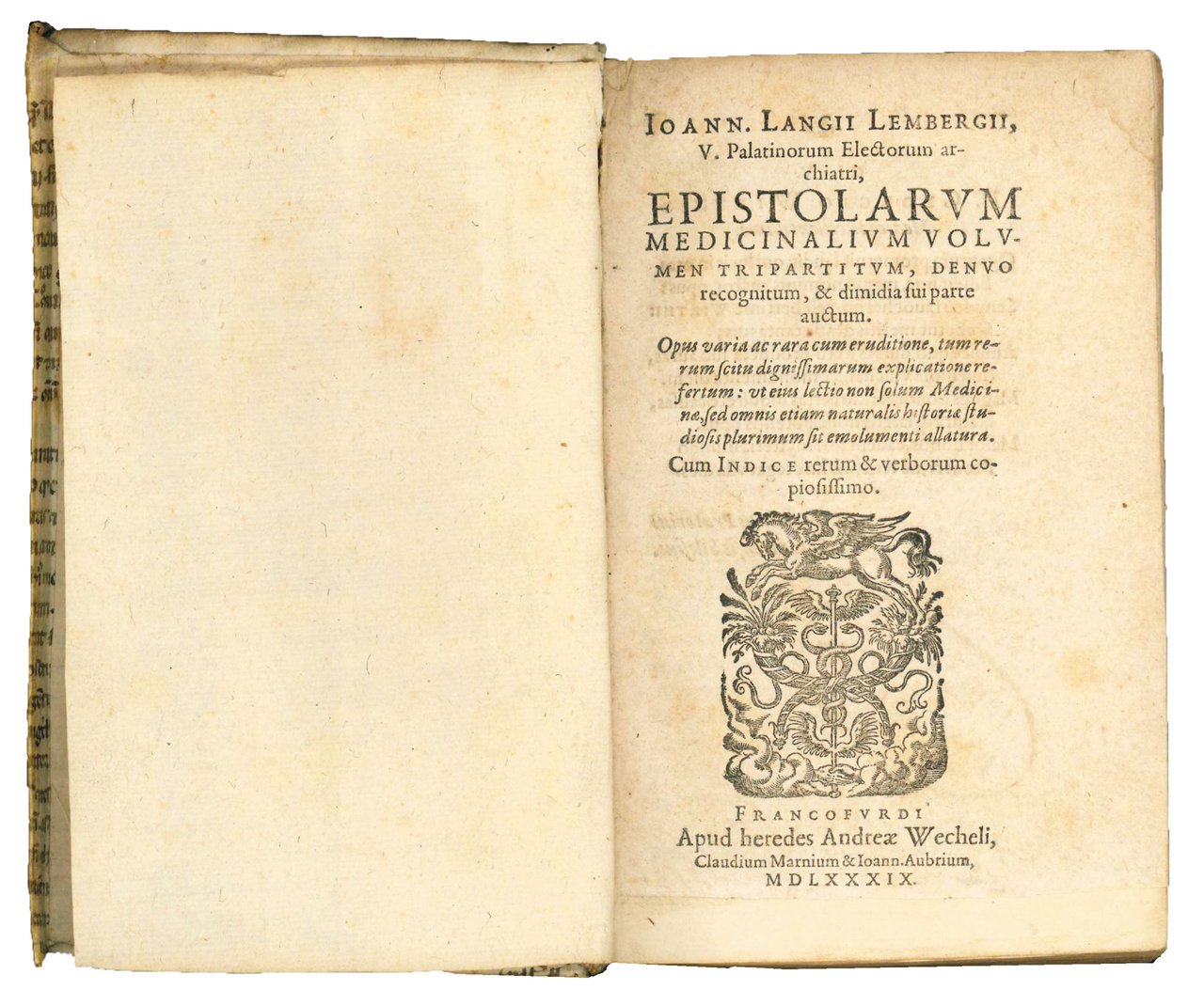

Rare and modern books
LANGE, Johannes (1485-1565)
Epistolarum medicinalium volumen tripartitum, denuo recognitum, & dimidia sui parte auctum. Opus varia ac rara cum eruditione, tum rerum scitu dignitissimarum explicatione refertum: ut eius lectio non solum Medicinæ, sed omnis etiam naturalis historiæ studiosis plurimum sit emolumenti allatura
Heirs of Andreas Wechel, Claude de Marne & Jean Aubry, 1589
850.00 €
Govi Libreria Antiquaria
(Modena, Italy)
The correct shipping costs are calculated once the shipping address is entered during order creation. One or more delivery methods are available at the Seller's own discretion: Standard, Express, Economy, In-store pick-up.
Bookshop shipping conditions:
For items priced over €300, it is possible to request an instalment plan from Maremagnum. Payment can be made with Carta del Docente, Carta della cultura giovani e del merito, Public Administration.
Delivery time is estimated according to the shipping time of the bookshop and the courier. In case of customs detention, delivery delays may occur. Any customs duties are charged to the recipient.
For more infoPayment methods
- PayPal
- Credit card
- Bank transfer
-
-
Find out how to use
your Carta del Docente -
Find out how to use
your Carta della cultura giovani e del merito
Details
Description
Adams, L-147; Durling, 2731; Wellcome Library, 3655; VD 16, L-331; Oswald Croll, Alchemomedizinische Briefe 1585 bis 1597, in: “Ausgewählte Werke”, II, (Stuttgart), 1998, pp. 5-6.
A FIRST COLLECTION of Lange's medical correspondence was published at Basel in 1554 by Johannes Oporin, who also printed a second volume in 1560. Some of Lange's letters were reprinted in Conrad Gesner's De chirurgia scriptores (Zürich, 1555) and in Epistolae medicinales (Lyon, 1556 and 1557). The present edition, in three books, is the most complete printed in the sixteenth century.
The first book contains the same eighty-three letters as in the 1554-edition, the second the same sixty-one letters of the second volume of 1560. The third newly added part consists of six long letters and a copious index of names and subjects.
The present edition was edited by Nikolas von Reusner (1545-1602), lawyer, historian, and Lange's compatriot. He studied first at Wittenberg under Melanchthon, later at Leipzig and obtained his doctorate in law at Basel. He achieved some fame after writing a series of laudatory verses for the members of the Diet of Augsburg. He taught law at the universities of Strasbourg and Jena and he was sent on a diplomatic mission to Krakow at the court of King Sigismund III. Emperor Rudolph II created him Count Palatine and poet laureate in 1594. Apart numerous juridical treatises Reusner wrote the text for the biographical dictionary illustrated by Tobias Stimmer Icones sive imagines virorum literis illustrium (1587) (cf. H. Wiegand, Nikolas von Reusner, in: “Literaturlexikon”, W. Killy, ed., Gütersloh & München, 1988-1991, IX, pp. 400-401).
Reusner dedicated the volume to a relative of Lange, the former personal physician to Emperor Charles V and King Philip of Spain, Georg Wirth, who was appointed his heir by Lange. This dedication letter, dated from Jena, February 1, 1589, contains also a short biography of Lange and a poem on Lange's woodcut portrait by Johannes Posthius from 1588.
The volume embraces a wide-ranging series of topics including surgery, ophthalmology, gynecology, alchemy, astrology, pharmacology, botany and the improvement of medical education in German universities. Lange is remembered to have introduced the practice of trephination in Germany and is credited with the first definite description of chlorosis (Garrison-Morton, 3109). In letter LXIII of the first book is found a long discussion (pp. 336-350) on America.
“Unter den deutschen Ärzten der ersten Hälfte des 16. Jahrhunderts, die dem Brauch der italienischen Meister folgten und wissenschaftliche Abhandlungen und Mitteilungen in Briefform kleideten, war Johannes Lange einer der frühesten Epistolographen. Sein Ansehen als Praktiker, die Stellung an einem illustren Fürstenhofe, noch mehr seine profunde Belesenheit in den Schriften der Alten verhalfen ihm wie seinen Briefen zu langwährender Berühmtheit [...] Langes Episteln erstecken sich auf die verschiedensten Materien der Heilkunde und ihre Nachbargebiete. Sie sind in der übergrossen Mehrzahl nach an bestimmte Perönlichkeiten gerichtet (oft nur mit dem Taufnamen bezeichnet), kein Schreiben trägt jedoch das Datum der Abfassung. Abweichend von anderen medizinischen Briefstellern schickt er der Sammlung eine Vorrede voran, um dem Leser zunächst die Gründe auseinanderzusetzen, die ihn zur Publikation der Briefe erwogen haben. Er sagt, es sei ihm nach der Rückkehr aus Italien die Rückständigkeit vieler Ärzte in Deutschland aufgefallen [...] Ebenso habe er den entsetzlichen Haufen der Chirurgen kennen gelernt, der jeglicher Bildung entbehrend und durchwegs Analphabeten, auf gut Glück ans Handwerk schreiten [...]” (V. Fossel, Aus den medizinischen Briefen des pfalzgräflichen Lei

